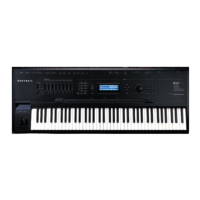6-44
Program Mode
The Envelope Control (ENVCTL) Page
Another difference is that AMPENV always controls the amplitude of the layer, so even if you
use it as a control source for other functions, it will still affect the layer’s amplitude. ENV2 and
ENV3 affect only those layers that have them assigned as a control source. Also, AMPENV uses
an exponential attack (the amplitude rises much faster at the end of the attack segment than it
does at the beginning), while ENV2 and ENV3 use linear attacks (the attack segment increases at
the same rate from start to finish).
The pages for Envelopes 2 and 3 are reached with the soft buttons ENV2 and ENV3. When you
select these pages, you’ll find a display that looks very much like the AMPENV page. The only
differences are that you can program an amount for Rel3; the Rel1 and Rel2 limits, which are
±100%; and in the envelope graphic, which has a dotted line running horizontally across the
display. This is the zero level line; negative level values for the various envelope segments will
cause the envelope graphic to dip below this line.
The Envelope Control (ENVCTL) Page
Envelopes are control sources with outputs that evolve over time without repeating (unless you
want them to). You can make the envelopes even more powerful by using envelope control. This
gives you realtime control over the rates of each section of the envelopes. Press the ENVCTL
soft button to reach the ENVCTL page.
The display’s top line reminds you of the current layer. The first line of text in the center of the
display shows five of the common DSP control parameters: Adjust, Key tracking, Velocity
tracking, and Source/Depth.

